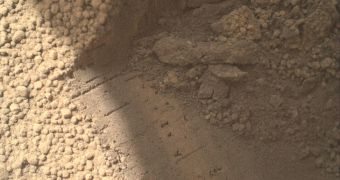Curiosity is getting down to business. The sand scooping business, that is. It's already discarded the second scoop which, like the first, was just to test the equipment and clean up the instruments, removing contaminants that could interfere with the results of the chemical analysis tools.
It's now getting ready for the third scoop, this one is the real deal, a sample from this scoop will be directed to Curiosity's CheMin (the Chemistry and Mineralogy) instrument, designed to detect minerals, for analysis.
Later, another sample from the same scoop will be directed to SAM (the Sample Analysis at Mars) instrument which is designed to detect simple elements like carbon, oxygen, hydrogen and nitrogen, the basic components of life, or at least organic material.
Detecting signs of life, past and present, or at least if life could exist or could have existed, is Curiosity's main mission on Mars.
While this part of the mission sounds routine, if anything done on Mars can be considered routine, there have been some interesting finds.
One "interesting," though not particularly welcome, find was a piece of plastic that fell off the rover. The second scoop, however, found more bright debris that the team initially believed to be more pieces from Curiosity.
Still, an investigation of the mark left in the ground by the third scoop, showed more of the bright particles in the Martian soil, indicating that they are native.

 14 DAY TRIAL //
14 DAY TRIAL //